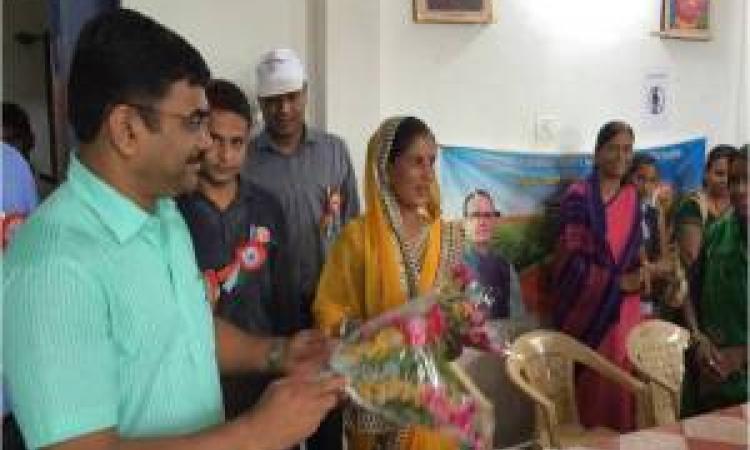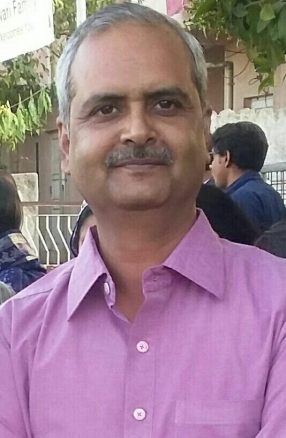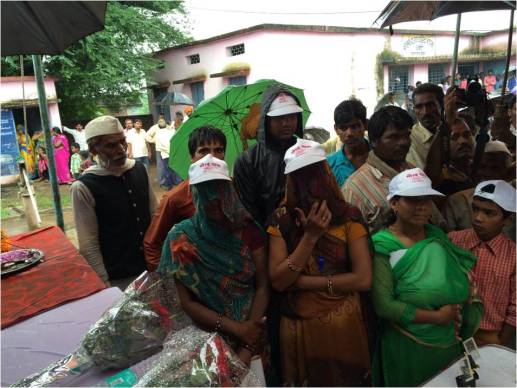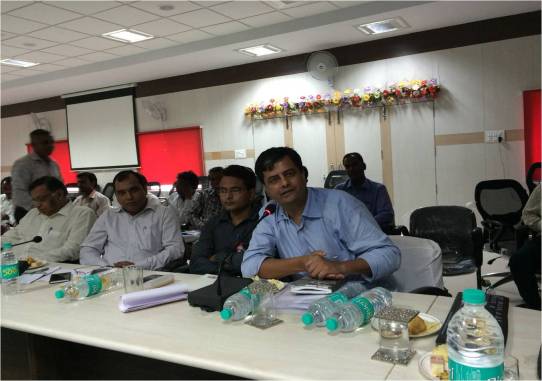
 Ajit Tiwari is Deputy Commissioner, Swachh Bharat Mission, Madhya Pradesh. Years ago, prior to the launch of Swachh Bharat, he was working as BDO of Budhni block in Sehore district, and was exposed to CLTS training. He says he went to the training every day thinking that he would attend that day only if he found it useful and ended up attending all five days. To convince himself of the practicality of approach, he started ‘triggering’ techniques in villages himself. Village after village began to become open defecation free (ODF) in his district. He became a proponent of community approach, and believes in it till date. A grassroot practitioner like him in the state-level team is good. At the state level, he is working with the same passion, implementing the system of directly transferring incentive to the person’s account, and propagating construction by the individuals rather than the gram panchayat.
Ajit Tiwari is Deputy Commissioner, Swachh Bharat Mission, Madhya Pradesh. Years ago, prior to the launch of Swachh Bharat, he was working as BDO of Budhni block in Sehore district, and was exposed to CLTS training. He says he went to the training every day thinking that he would attend that day only if he found it useful and ended up attending all five days. To convince himself of the practicality of approach, he started ‘triggering’ techniques in villages himself. Village after village began to become open defecation free (ODF) in his district. He became a proponent of community approach, and believes in it till date. A grassroot practitioner like him in the state-level team is good. At the state level, he is working with the same passion, implementing the system of directly transferring incentive to the person’s account, and propagating construction by the individuals rather than the gram panchayat.
Harda is a district in Madhya Pradesh which has been declared ODF recently. A district where Ganesh Mishra, ex-CEO, zilla panchayat (ZP), and now, ADM, started the campaign Operation Malyudhha did not suffer upon his transfer as ADM in the same district. His successor is his wife, Shanmuga Priya. Shanmuga not only took off from where Ganesh left, but took it to the logical end of ODF district through meticulous planning, focus on processes and innovations. She also got full support from the revenue administration--collector Srikant and his team.
Ganesh says that there are five things required for a district to become ODF. The first is the leadership, and the mindset of the leadership. Once the collector or the CEO, ZP are motivated and have clarity of approach about community engagement and behaviour change, they can make this campaign successful. Fortunately, in Madhya Pradesh, both collectors and CEOs are involved in Swachh Bharat that acts as a double booster. Some other states where CEOs are in charge of development--Gujarat, Maharashtra and Karnataka-- collectors are not involved closely. There are reasons for this, because the developmental role is with the CEOs, however Swachh Bharat may require an ‘all hands on deck’ approach.
The second thing Ganesh emphasises is capacity building. Given that this programme is very different from most government programmes, it does not require people’s involvement in a superficial sense; it is a people’s programme. The subtle differences between informing people and involving people needs to be understood. This requires regular trainings by experts, refresher training and trainings of all possible stakeholders, so that there is a common understanding of issues by everyone.
The third thing, according to Ganesh is: Do it before you judge it. He believes that once you get into it, and do it rightly, it will be addictive. He also talks of an “iterative strategy--doing, improving. The district first worked with preraks (grassroot motivators) who were government staff. Then they realised that these preraks could not give enough time to swachhta work due to their other duties, or did not have the right skill or aptitude required for this kind of work. Therefore, they moved to selecting preraks from amongst villagers themselves. And finally, he recommends "completing it before the fatigue sets in". He mentions that the work requires a lot of time, energy, passion and working in top gear continuously. This degree of intense work can sustain for a few months to a year, may be. And therefore, one needs to finish it within that time.
Innovations in districts
A lot of innovations are happening at the district level. Sudam Khade, collector, Sehore--a swachhta champion--has devised and implemented a ‘tippy-tap’ across all the anganwadis in his district. He is now planning to do it in all the schools as well. ‘Tippy-tap’ is a simple device, where a can with a hole can be moved by a foot-driven stick to pour water for hand washing. Ganesh is also advocating disability and elderly-friendly toilets through simple, yet effective innovations--like a small hook in the toilet to help stand up from the squatting position.
Harda district has been a laboratory of innovations. The district has given ideas like ‘gift a toilet on Rakshabandhan festival’ by brothers to sisters; ODF Olympics--sports for villagers from ODF villages; meticulous procedure to select preraks involving skill testing, group discussion and physical test; policy of no expenditure on IEC till the village actually becomes ODF; and a very strict verification procedure. The district has taken efforts to engage the zilla panchayat members proactively. Orienting them to the cause of ODF, some members felt agitated on the repeated use of the word ‘gun‘ (faeces). Ganesh, who was facilitating the orientation deftly handled the situation, saying, "Ok, we will not use the word ‘gun, we will call it ‘jalebi'." And used the word ‘jalebi' for faeces thereafter in the workshop. This had a better impact--he told everyone that if they were agitated about the situation, his purpose was served. They had been triggered.
Scaling up
Madhya Pradesh is working now to scale up the efforts. Work is happening well in around 10 districts (in central and southern Madhya Pradesh mainly, but some in western Madhya Pradesh, too). The challenge is to spread this fire to the remaining districts. This requires further prioritisation of sanitation in the overall development agenda of the state. A talisman is the frequency with which the chief minister/chief secretary of a state reviews collectors/CEOs on this programme, and the order of priority of sanitation in the agenda for such reviews.
Electronic transfer of funds to households
Madhya Pradesh has traditionally had sarpanches constructing the toilets for people. This was leading to some problems--delay in construction, uniform construction, people not using due to behavioural reasons but blaming sarpanch for poor construction, theft of material procured collectively, etc. The preraks recruited for motivation were also primarily getting involved in facilitating actual construction of toilets. Since this task was part of prerak’s responsibilty, the work on behaviour change was being inordinately hurried.
The state had been working on behaviour change for few years and felt that there was some demand generation and that there would be a set of people who can construct toilets on their own, provided the system of incentives can be streamlined. They did the following:
1. They made public (on website, and through village staff) the list of people who were ‘eligible’ to get incentive.
2. They nominated a block-level supervisory officer for a village or a few villages and made this information public. They also disseminated information about toilet technology to people.
3. They started operating a single bank account at the state level and withdrew funds that were lying in different panchayats--the amont was a whopping Rs 3000 million.
4. They took the help of Punjab National Bank to put in place a system of direct electronic transfer of fund to each household. This system functions like this--any person whose name is in the eligible list can start constructing his toilet. After the toilet is completed and after verifying his account number for incentive grant (he can take help of village secretary for this), he raises the demand online. Once this demand is placed, the block supervisor will visit his house, upload the picture and accept or reject his claim, all within seven days. This decision is also public, and if found wrong, the household can contest the decision. Once the supervisor has made online entry of acceptance of claim, the BDO processes online payment to the account of that person. The digital signatures of all BDOs available with MGNREGA, as also the accounts of people (many done during Jandhan Yojana), were captured in this system. When the system was to be introduced, there was apprehension that the pace of work would slow down and people would not come forward. However, this has not been the case and within one month of launching the system, 61,000 people have placed the demand.
The system is at variance with the community approach, wherein collective behavioural change is triggered in the entire community. The understanding in MP is that while the work on behaviour change may continue, those who are ready to construct toilets, their process may be facilitated. Once this is done, how the remaining, who are usually the poorest and the most vulnerable, will be covered remains to be seen. Unless that is done, health benefits may be suboptimal. A field officer remarks, "It is early days, and how useful this system will turn out to be, remains to be seen."
Capacity building
On software activities, the state has taken help of Feedback Foundation (supported by UNICEF), but more importantly, the state is building in-house capacity for training in community approaches. The state has trained around 4500 preraks in community approaches across the state. Twenty two workers among them, who were found to be the best, have been engaged by the state for training, and follow ups. The master trainers amongst them are paid Rs 2500 per day, and the rest, Rs 1500 per day. These 22 people were earlier supported by WaterAid, but now, the state engages them directly. The preraks in districts are non-governmental local people, selected by the districts, looking at their aptitude, capability etc. Harda adopted a wonderful system of recruiting preraks through advertisement, group discussion, interview, physical test and also got a bond filled from them after they were trained. Many other districts and the state seem to have learned from them and adopted similar systems. The system of paying incentives to these preraks and monitoring their work is also being put in place. The SBMG guidines provide an indicative manpower structure at the state, district and block levels. While some states have this manpower in place, some don’t. And this needs a close review and cajoling.
Big things
ODF and sanitation are finally a priority issue in the country. For the districts, states and certainly for the country, swachhta is not something that is paid only lip service and ignored. A written communication on Swachh Bharat from the centre is taken seriously; it is not ‘one of the many’ letters. Secondly, a BDO, proudly saying that he is called gun waale saheb (shit officer) reminded me of my days in Jalna, Maharashtra, where I was known as hagandari che CEO orCEO of shit.
Moreover, the concept of ODF is ensuring inclusion and coverage of the most vulnerable and difficult-to-cover categories. For eg, districts are addressing sanitation issues of migrant labourers in appropriate ways. It is also being understood that ODF achievement is a one-time activity that will have to be sustained on its own by the people and the villages (having been ingrained in the habits and culture) and without further dependence on the government. Sudam Khade picked up the idea of non partition of the house unless the new house has a toilet-- and instructed all his officials accordingly.
Lastly, the programme is reaching the stage where all answers are not sought necessarily from the government--there are discussions, and many answers/solutions arise from the people/villagers themselves.
Unsung heroes

The campaign is producing many grassroot champions, the work or the contribution of many may not even be known at the higher levels although the people for whom they are working will never forget them. These champions comprise sarpanches, other natural leaders from villages, preraks and grassroot functionaries (could be village secretaries, anganwadi workers etc.) A prerak shared how a person had a toilet but the pit was open. He did not use the toilet but defecated around the toilet. Despite trying to convince him, neither did he use the toilet, nor did he cover the pit. Then the prerak and his team covered the pit, and also began to cover his feces with soil everyday. He felt ashamed and started using the toilet. Another prerak recalled how he was posted in a tribal village, 70km away from his home, and how he would sometimes spend the night hungry. He stuck on till the village became ODF. His village got the championship trophy in ODF Olympics and he proudly shared that event. A girl prerak was so motivated that she actually stood at the site of open defecation and stopped the villagers from the act. Many people would even fight with her, but she continued her work till the village became ODF. A sarpanch--who after making his own village ODF moved from village to village spreading the message-- mentioned that he broke his functional septic tank toilet and constructed a twin-pit one, just to convince his village that a septic tank toilet is not better than a twin pit.
In the rural areas of MP, women wear purdah (veil). For Swachh Bharat, these women with veils, who do not otherwise come in the public, are active in the nigrani samitis (early morning monitoring committees) and go out every morning to check that no one is defecating in the open.
 Mangesh, a highly educated person, left his job in the metro city to work at grassroot levels. He is associated with the NGO, Samarthan that is doing great work in Sehore district of Madhya Pradesh. His organisation plays three critical roles--one they explain the governmental guideline, circular etc. in simple language to the people. Thus they explain to the people the programme, how it is to be achieved and the approach/philosophy behind it in their own language. Secondly, they also bring back critical feedback to the district administration, so that they can further make necessary changes in the implementation strategy. Thirdly, they also suggest critical innovations, arising from their working in the field to the district administration for considering scaling up.
Mangesh, a highly educated person, left his job in the metro city to work at grassroot levels. He is associated with the NGO, Samarthan that is doing great work in Sehore district of Madhya Pradesh. His organisation plays three critical roles--one they explain the governmental guideline, circular etc. in simple language to the people. Thus they explain to the people the programme, how it is to be achieved and the approach/philosophy behind it in their own language. Secondly, they also bring back critical feedback to the district administration, so that they can further make necessary changes in the implementation strategy. Thirdly, they also suggest critical innovations, arising from their working in the field to the district administration for considering scaling up.
Anganwadis are the place where swachhta habits are to be first inculcated. Presence of toilets in anganwadis are therefore a must. Sadly, there is no dedicated funding for these toilets. Many enterprising collectors address this problem by shifting anganwadis in schools or in such private buildings where there is a toilet, however the problem needs a permanent solution through dedicated funding. It is an asset much more important than a road or a drain.
Implementation
On the implementation side, within the broad understanding of “what works”, each village/district/state may have to continuously evaluate, revaluate, respond and reform. The swachhta campaign not only gets toilets built and reduces gandgi, it also challenges many social power norms. It may not be wrong to look at Swachh Bharat as an important intervention for social cohesion--ODF bringing people from all castes and communities in a village together around a single, desirable goal.
When Madhya Pradesh started Maryada Abhyaan, portraying sanitation as essential to protect women's dignity, some organisations objected to the campaign depicting women going out and men looking at them. The state government brought the prerak women working for the campaign face-to-face with those objecting, and the preraks made a strong case for continuing the campaign, confirming that women do face harassment when they go out, and therefore sanitation campaign rightly raises this issue. Leaving aside the merits of this for a while, what cannot be denied is that a) issues can no longer be swept under the carpet b) looking at sanitation as a behavioural issue necessitates touching and challenging ‘social norm’ chords and c) if they lead to purging of retrograde norms, sanitation would achieve much beyond cleanliness.
Much is said about defunct toilets. Surprisingly, the districts that are performing well (champions) hardly bring up this issue. These districts seem to be addressing this issue at their level in a much more pragmatic and economic way. They profile these people, swap to include them in the eligible list by excluding other non-genuine beneficiaries, or those who can construct on their own, arrange for local materials through village support, panchayat funds, some philanthropists, etc to the extent required to make the toilet functional (and not a necessary 12,000 rupees), bring in innovations--like gifting toilet to someone on Rakhi festival etc. and not look up to government for funds for these. Besides the resource-availability part, there is a certain merit in these local solutions, since this a) fosters collective spirit b) promotes innovation; but most importantly c) makes the process self-sustainable. In case we look up for funds for defunct toilets now, what guarantee is there that we will not be asking again for funds for toilets that may become defunct few years later?
A programme of this magnitude needs dedicated people. The most important are the grassroot motivators. Harda has good examples of taking great care in recruiting them. Their experience is that the government staff is not able to give much time, given their other duties, and while they can be in supportive role, the motivators should be non-governmental people from villages. There seems to be some merit in this argument. The second thing is proper training of these motivators. A five-day training module in community approaches is minimal. Ganesh shared that these trainings were repeatedly carried out for different stakeholders followed by refresher trainings. They converted the five-day module into a one-day module for the government staff--anganwadi workers, teachers etc--while the longer module was for the Swachh Bharat motivators and for the core team. Besides the grassroot motivators, training is given to all grassroot government functionaries, who play a supportive role.
As the hard core IPC triggering work continues in villages, periodic campaigns are helpful to increase the momentum. Various festivals in India provide opportunity for this. The sense of district pride is also being appropriately used for the programme, with many districts branding their campaigns: Good morning Sehore, Operation Malyudhha, etc. There is political involvement, although the programme can get a boost if they put more energies into it. Amongst various micro-village techniques, early morning follow-ups remain a very effective tool in pulling villages out of open defecation; and in changing the perspective from toilet construction to ODF. Technology myths and preference for septic tanks remain. For that, the demonstration of construction of toilet to villagers seems to be a useful way to dispel the myths and clarify doubts about toilet construction. Involvement and contribution of women to the Swachh Bharat remains paramount.
Taking a cue from Harda, it may not be a bad idea to organise sports events for ODF villages. A prerak from Harda who worked in a tribal district shared with immense happiness how their village won the trophy. Sports can rejuvenate the team spirit, as well as the competitive spirit--both boosters for the swachhta campaign.
Policy
On the policy side, there is a definite merit in incentivising those villages that perform well in sanitation outcomes (not just outputs!). The new World Bank project will do precisely that-- assess performance of states against the outcomes of reduction in open defecation (measured by access, usage and safety of technology), sustainability of ODF status and solid/liquid waste management assessed through an independent national annual rural sanitation survey on a sample basis. The union budget has also announced prioritisation of all centre- sponsored schemes in ODF villages--the states may also consider prioritising their schemes, as far as possible, in these villages.
The ODF villages have to be positively discriminated, ODF status should become aspirational, and be suitably rewarded. Rewards may not necessarily be monetary. In MP, a Kakaji, dared to stop the chief minister’s vehicle and ask him why he was touring those villages which were still dirty, and not his village, where they had taken so much effort to make it ODF. The chief minister, in his next trip to the district, visited 27 ODF villages. He almost always attends programme of declaration of a block as ODF. The Harda administration (and many more) provide a VIP direct entry and access to villagers from ODF villages.
This piece has been reproduced with permission from the author. Views expressed in this article are personal. This article was originally published on the author's personal blog here.